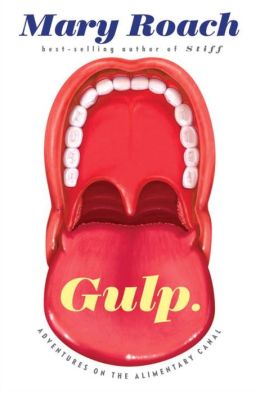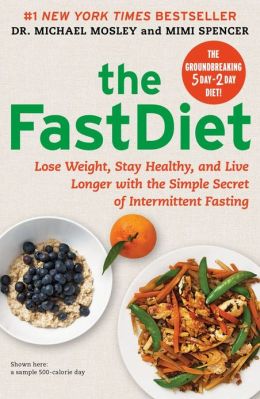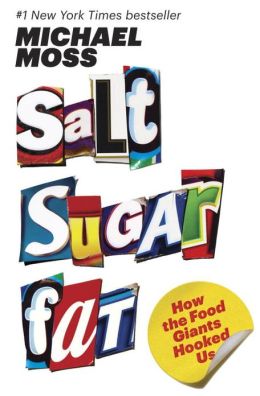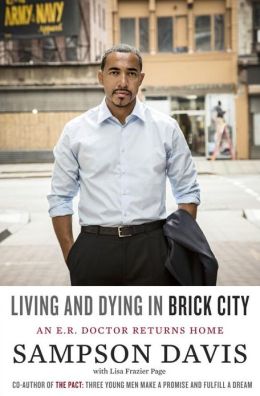by Mary Roach (Find this book)
The irresistible, ever-curious, and always best-selling Mary Roach
returns with a new adventure to the invisible realm we carry around
inside.
“America’s funniest science writer” (Washington Post) takes us down the
hatch on an unforgettable tour. The alimentary canal is classic Mary
Roach terrain: the questions explored in Gulp are as taboo, in their
way, as the cadavers in Stiff and every bit as surreal as the universe
of zero gravity explored in Packing for Mars. Why is crunchy food so
appealing? Why is it so hard to find words for flavors and smells? Why
doesn’t the stomach digest itself? How much can you eat before your
stomach bursts? Can constipation kill you? Did it kill Elvis? In Gulp we
meet scientists who tackle the questions no one else thinks of—or has
the courage to ask. We go on location to a pet-food taste-test lab, a
fecal transplant, and into a live stomach to observe the fate of a meal.
With Roach at our side, we travel the world, meeting murderers and mad
scientists, Eskimos and exorcists (who have occasionally administered
holy water rectally), rabbis and terrorists—who, it turns out, for
practical reasons do not conceal bombs in their digestive tracts.
Like all of Roach’s books, Gulp is as much about human beings as it is about human bodies. -- Publisher Marketing
Health and Medicine Titles
You can check availability by clicking the links!
Tuesday, January 27, 2015
Tuesday, January 20, 2015
The FastDiet: Lose Weight, Stay Healthy, and Live Longer with the Simple Secret of Intermittent Fasting
by Michael Mosley (Find this book)
The #1 New York Times bestseller!
Is it possible to eat normally, five days a week, and become slimmer and healthier as a result?
Is it possible to eat normally, five days a week, and become slimmer and healthier as a result?
Simple answer: yes. You just
limit your calorie intake for two nonconsecutive days each week—500
calories for women, 600 for men. You’ll lose weight quickly and
effortlessly with the FastDiet.
Scientific trials of intermittent
fasters have shown that it will not only help the pounds fly off, but
also reduce your risk of a range of diseases from diabetes to
cardiovascular disease and even cancer. “The scientific evidence is
strong that intermittent fasting can improve health,” says Dr. Mark
Mattson, Chief of the Laboratory of Neurosciences, National Institute on
Aging, and Professor of Neuroscience, Johns Hopkins University.
This book brings together the
results of new, groundbreaking research to create a dietary program that
can be incorporated into your busy daily life, featuring:
• Forty 500- and 600-calorie meals that are quick and easy to make
• 8 pages of photos that show you what a typical “fasting meal” looks like
• The cutting-edge science behind the program
• A calorie counter that makes dieting easy
• And much more.
• 8 pages of photos that show you what a typical “fasting meal” looks like
• The cutting-edge science behind the program
• A calorie counter that makes dieting easy
• And much more.
Far from being just another fad,
the FastDiet is a radical new way of thinking about food, a lifestyle
choice that could transform your health. This is your indispensable
guide to simple and effective weight loss, without fuss or the need to
endlessly deprive yourself. -- Publisher Marketing
Tuesday, January 13, 2015
Salt Sugar Fat: How the Food Giants Hooked Us
by Michael Moss (Find this book)
A revelatory look at America's increasing consumption of unhealthy products and at how the biggest food manufacturers ignore health risks, and employ savvy advertising campaigns, to keep us hooked on the ingredients that ensure big profit. In an era where morbid numbers of people are living with diabetes, obesity and high blood pressure, New York Times Pulitzer Prize-winning reporter Moss (Palace Coup, 1989) discovers through ardent research--much of it interviews with current and former executives of Kraft, PepsiCo and other massive conglomerates--that there is shockingly little regulation of the processes behind the design and sale of foods purposely laden with dangerous levels of salt, sugar and fat. As the average American works longer hours and spends more time outside of the home, the demand for easy-to-cook and tasty meals has skyrocketed. In response, food giants provide an enormous slate of processed food options, almost all of which require immense amounts of salt, fat and/or sugar to cover the taste of poor-quality ingredients. Pulling no punches, the author points out that the recent trend of "healthy" items is no loss for these food manufacturers, who capitalize on creating new lines of spinoff products labeled "low-salt" or "sugar-free," when in fact those products require a significant increase in one of the other triad of flavors to remain palatable. Many products are laden with these ingredients in ways that would surprise the consumer: A single cookie, for example, might require several servings' worth of undetectable salt to retain its irresistible crunch, while it also contains up to five teaspoons of sugar. Moss breaks down the chemical science behind the molecular appeal of these foods, as well as behind the advertising strategies that are so successful in getting consumers to buy not only the "healthier" versions of popular foods, but the originals, as well. If this trend is to be reversed, he argues, it might take a social revolution of empowered consumers, a goal within reach if accurate information is available and pressure is put on these companies to dramatically alter the contents of its processed foods. A shocking, galvanizing manifesto against the corporations manipulating nutrition to fatten their bottom line--one of the most important books of the year. COPYRIGHT(2013) Kirkus Reviews, ALL RIGHTS RESERVED.
A revelatory look at America's increasing consumption of unhealthy products and at how the biggest food manufacturers ignore health risks, and employ savvy advertising campaigns, to keep us hooked on the ingredients that ensure big profit. In an era where morbid numbers of people are living with diabetes, obesity and high blood pressure, New York Times Pulitzer Prize-winning reporter Moss (Palace Coup, 1989) discovers through ardent research--much of it interviews with current and former executives of Kraft, PepsiCo and other massive conglomerates--that there is shockingly little regulation of the processes behind the design and sale of foods purposely laden with dangerous levels of salt, sugar and fat. As the average American works longer hours and spends more time outside of the home, the demand for easy-to-cook and tasty meals has skyrocketed. In response, food giants provide an enormous slate of processed food options, almost all of which require immense amounts of salt, fat and/or sugar to cover the taste of poor-quality ingredients. Pulling no punches, the author points out that the recent trend of "healthy" items is no loss for these food manufacturers, who capitalize on creating new lines of spinoff products labeled "low-salt" or "sugar-free," when in fact those products require a significant increase in one of the other triad of flavors to remain palatable. Many products are laden with these ingredients in ways that would surprise the consumer: A single cookie, for example, might require several servings' worth of undetectable salt to retain its irresistible crunch, while it also contains up to five teaspoons of sugar. Moss breaks down the chemical science behind the molecular appeal of these foods, as well as behind the advertising strategies that are so successful in getting consumers to buy not only the "healthier" versions of popular foods, but the originals, as well. If this trend is to be reversed, he argues, it might take a social revolution of empowered consumers, a goal within reach if accurate information is available and pressure is put on these companies to dramatically alter the contents of its processed foods. A shocking, galvanizing manifesto against the corporations manipulating nutrition to fatten their bottom line--one of the most important books of the year. COPYRIGHT(2013) Kirkus Reviews, ALL RIGHTS RESERVED.
Tuesday, January 6, 2015
Living and Dying in Brick City: An E.R. Doctor Returns Home
by Sampson Davis (Find this book)
A riveting personal exploration of the healthcare crisis facing inner-city communities, written by an emergency room physician who grew up in the very neighborhood he is now serving Sampson Davis is best known as one of three friends from inner-city Newark who made a pact in high school to become doctors. Their book The Pact and their work through the Three Doctors Foundation have inspired countless young men and women to strive for goals they otherwise would not have dreamed they could attain. In this book, Dr. Davis looks at the healthcare crisis in the inner city from a rare perspective: as a doctor who works on the front line of emergency medical care in the community where he grew up, and as a member of that community who has faced the same challenges as the people he treats every day. He also offers invaluable practical advice for those living in such communities, where conditions like asthma, heart disease, stroke, obesity, and AIDS are disproportionately endemic. Dr. Davis's sister, a drug addict, died of AIDS; his brother is now paralyzed and confined to a wheelchair as a result of a bar fight; and he himself did time in juvenile detention-a wake-up call that changed his life. He recounts recognizing a young man who is brought to the E.R. with critical gunshot wounds as someone who was arrested with him when he was a teenager during a robbery gone bad; describes a patient whose case of sickle-cell anemia rouses an ethical dilemma; and explains the difficulty he has convincing his landlord and friend, an older woman, to go to the hospital for much-needed treatment. With empathy and hard-earned wisdom, Living and Dying in Brick City presents an urgent picture of medical care in our cities. It is an important resource guide for anyone at risk, anyone close to those at risk, and anyone who cares about the fate of our cities. -- Publisher Marketing
A riveting personal exploration of the healthcare crisis facing inner-city communities, written by an emergency room physician who grew up in the very neighborhood he is now serving Sampson Davis is best known as one of three friends from inner-city Newark who made a pact in high school to become doctors. Their book The Pact and their work through the Three Doctors Foundation have inspired countless young men and women to strive for goals they otherwise would not have dreamed they could attain. In this book, Dr. Davis looks at the healthcare crisis in the inner city from a rare perspective: as a doctor who works on the front line of emergency medical care in the community where he grew up, and as a member of that community who has faced the same challenges as the people he treats every day. He also offers invaluable practical advice for those living in such communities, where conditions like asthma, heart disease, stroke, obesity, and AIDS are disproportionately endemic. Dr. Davis's sister, a drug addict, died of AIDS; his brother is now paralyzed and confined to a wheelchair as a result of a bar fight; and he himself did time in juvenile detention-a wake-up call that changed his life. He recounts recognizing a young man who is brought to the E.R. with critical gunshot wounds as someone who was arrested with him when he was a teenager during a robbery gone bad; describes a patient whose case of sickle-cell anemia rouses an ethical dilemma; and explains the difficulty he has convincing his landlord and friend, an older woman, to go to the hospital for much-needed treatment. With empathy and hard-earned wisdom, Living and Dying in Brick City presents an urgent picture of medical care in our cities. It is an important resource guide for anyone at risk, anyone close to those at risk, and anyone who cares about the fate of our cities. -- Publisher Marketing
Subscribe to:
Posts (Atom)




